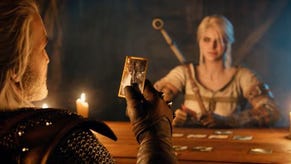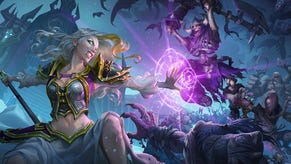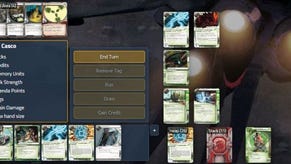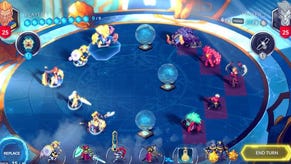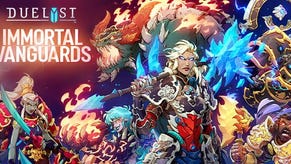Impressions: Duelyst
Feud for Thought
If this year’s E3 was anything to go by, 2015 may well prove to be the year of the collectible card game. All the big names seemed to have one, but none of them seemed to be able to tell you why theirs was the one you should play. For me, these johnny-come-latelys may have already been rather handily upstaged: none seemed to advertise anything like the ingenuity of the free-to-play Duelyst [official site], with its whip-smart mixture of card play and turnbased tactics, whereby you summon fantastical units to a gridded arena and duke it out until one general falls.
It’s in closed alpha at the moment, and I’ve been really enjoying it - though I feel I’ve barely scratched the surface of the strategies that are possible. Luckily, I’ve been able to pick the ample brains of Counterplay Games’ Keith Lee about Duelyst’s six factions, their varied tactics and the long-term ambitions to use the aggregated wins and losses of players to inform an ongoing epic narrative.
It’s a pacey little game, in which confrontation is ignited almost immediately and wraps up with the death of one player’s general in about ten minutes time. But though its bouts are short, its tactical depth is far from trivial, and each faction offers thrilling asymmetry and distinctive synergies between the various spells and units they can play. Of the many things I like about it, first and foremost is the fact that each player’s general is a physical presence on the board. Alongside cards that summon units and cards that cast spells is a third tier of cards: artefacts which allow you to empower your general alone, potentially making them a bulwark of the battlefield. But at no little risk: lose your general, and you lose the game.
“When we first started designing this game a year and half ago, we were playing a lot of games like Hearthstone and Heroes of Might and Magic,” says Lee. “We love those games, but we felt we wanted a game with very clear victory conditions. We didn’t want the player to have to calculate victory points like a board game, and we wanted it to be really intuitive and compress it into a short ten minute session. So we liked the fantasy of having a general, and decided he should be on the battlefield itself - it felt weird in Might and Magic that your general is abstracted out. The moment we prototyped this, it immediately felt more intuitive. And that opened up new opportunities: gear that only your general can equip. So do you keep your general at the back, or do I go in much more aggressively and put the general into the battle itself? It becomes a really interesting gameplay tradeoff.”
But even if you choose discretion, the game doesn’t really allow you much opportunity to turtle. In the centre of the board are three mana fountains - capture one of those tiles by moving onto it or summoning a unit there, and you’ll gain a boost to your mana pool for that round, allowing you to summon higher powered units earlier in the game than you otherwise might. Play too defensively, and you will concede this advantage to your opponent. But, equally, overstretching yourself early on, when you have few units to block opponents from reaching your general, can quickly lead to disaster.
Positioning is vitally important: you can’t move through enemies and can only summon units to squares adjacent to friendlies. Get blocked in, and you may well be screwed. I’ve played a bit as the Abyssian faction - one of their tricks is to summon a swarm of weak, nightmarish sprites, plonking one down after another in a single turn. You can quickly encircle an enemy and deny them movement, forcing them to waste their next turn swatting away your minions. A rather sinister, vault-dwelling people, the Abyssians have devised their own type of macabre magic: “They have an ability called Deathwatch,” explains Lee. “It triggers abilities and effects when any unit dies on the battlefield.” This can prove particularly devastating when used in combination with your swarms of fragile monsters, forcing the opponent to choose between paralysis and grudgingly springing your Deathwatch trap.
“They also have Shadowcreep,” continues Lee. “It can be planted on the ground and when enemies occupy that tile they get damaged.” Another faction, the Lyonar, favour close formations and can gain massive buffs when clustered - Shadowcreep is a nightmare for them in particular, Lee explains. “Drop a two-by-two Shadowcreep on them and now they have to move and spread their units apart.”
The Lyonar are nonetheless one of the hardier factions, and one of the few to riff on more familiar Western fantasy tropes, with their chunky plate-armoured knights. The Songhai are almost their opposite: “They’re more mage-like or rogue-like,” says Lee. “They have very high burst damage and spell efficiency, and more of an asian cultural vibe. Some Songhai units have the Backstab ability, so you do more damage when you’re behind an enemy, and prevents strikeback damage from your opponent.
“Vetruvian are like a Stargate cyber-Egyptian class. They have these immovable obelisks that they can plant on the battlefield that’ll continuously spawn enemies. They also have really powerful abilities like Blast, which allows a unit to hit all enemies in a straight line across the battlefield.
“Magmar are a combination of dragons and dinosaurs - a cool monster class. They have the Rebirth ability: if you’re able to kill a unit, they’ll leave an egg, and if you don’t kill that egg soon, a new form of that monster will come back. They also have Grow - every turn they get stronger and stronger.”
The final faction, the Nordic-themed ice-wizards of Vanar, are the most technical according to Lee, with lots of area denial, allowing them to conjure walls to block or funnel enemies, and tricksy spells that flip units' defence and attack stats or return minions to the enemy's hand.
Fortunately, there is help at hand to explain these many elaborate strategies: a codex, which combines both lore and gameplay tips, and a series of challenges “designed to let people experiment with different combinations in a guided way”, that quickly segue from tutorial basics to tough puzzles of procedure. The team are also looking to find ways of encouraging more experienced players to mentor newbies through guilds. And then there’s the progression system, which ensures you aren’t overwhelmed by the 300 possible cards from the get go, and instead unlock batches of skill-level-appropriate cards as you level up each faction.
Needless to say, this also provides incentive for the player to splash some cash to hurry that progress along. But as far as F2P economies go, this appears at present to be one of the less aggressive, with an ample supply of cards for each factions unlocked from the start. I’ll need to see how it plays out over the long term, but my feeling is that the ways you can spend money don’t risk distorting the game too badly: you can’t buy specific cards, only random batches of five, and there are plenty of ways to earn the in-game currency, too, through daily quests.
Counterplay Games will also sell cosmetic items for real world cash in the hopes of sustaining their development effort across the coming years. Lee says they’re in it for the long haul, and their narrative ambitions for the game suggest this is not merely puff. Normally, I’d be cautious about endorsing the necessity for an abundance of lore in a CCG - but here it’s a framework designed to support a rolling player-driven story, planned to unfold over the course of years.
“We’re going to create a system where the decisions that people make in the game will change and evolve the storyline,” says Lee. “If you come back to the game, let’s say, a year later, we’ll actually chronicle and catalogue the events that have occurred and freeze it as a book.”
The success of the various factions in the meta will be one of the contributing factors to the direction the story takes, says Lee. “We’ll also have an overworld map where people will start to take territories. And we haven’t announced this yet, but we do plan to have guilds and ways for friends to work together. We’re really interested to see how we can create these social constructs that allow players to self-organise and do cool things together.”
Lee cites Bungie’s Myth, The Black Company fantasy novels and the work of author Joe Abercrombie as tonal inspirations for their setting: a vibrantly imagined world composed of floating islands of rock, which orbit around a huge monolith, and align only rarely to allow land access to the centre. When this happens, the city states that exist on these floating rocks send emissaries on a pilgrimage to the monolith where they do battle to claim cores - a powerful energy source.
“It’s a very similar situation to the Tragedy of the Commons,” Lee says. “Each city state gradually transitions their entire focus from hoarding as many cores as possible to powering their continent’s anti-entropic field. So to avoid a cataclysmic war each nation agrees to a rigorous standardised set of trials and rules and tournaments to properly earn and distribute these cores. That’s a tenuous balance of power.”
I’m intrigued by the direction this is heading - but I’m more easily persuaded by Duelyst on the basis of its snappy, tactical combat, and the fact that the game exists not merely to service an old IP - like so many upcoming CCGs, MOBAs and other me-too genres - but appears to be attempting boldly novel things with its peculiar blend of mechanics. While the megabranded Star Wars and Elder Scrolls CCGs prepare to slug it out, it's the Duelyst - smaller, sleeker and smarter - that may prove the more deserving victor.











